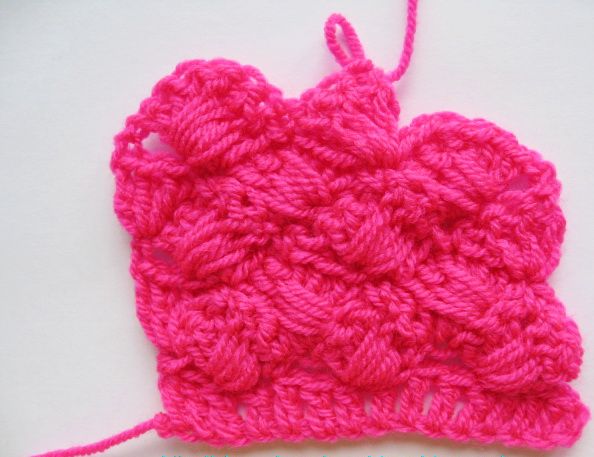
The motif of the pattern consists of two groups of crossed bars, three columns with nakida in each group and one column without nakida.
Pattern start knitting over the edge of columns with nakida, related to the main chain. So, to link primary chain, make SC, enter the hook into the third loop of the chain, catch the working thread and pull the loop again to catch the working thread, and knit into two loops with the hook in one step, catch the working thread, and knit into both stitches from the hook to the second reception. Associated the first column with nakida. Knit according to this column on each loop main chain to end of row. Turn the knitting right to left, make a yo, not promazyvaya boundary loops, to introduce the hook under the loop of the fourth column, pick up the working thread and pull a loop. Knit into the loops with the hook in two stages, in two loops together for the reception. Associated the first column with nakida with a slope to the right. To tie into the same loop two more column with nakida, only three columns with nakida, with a slope to the right. To do yo, enter the hook in the first group of three columns under the loop of the third missed the column and bind it on three columns with nakida. Connected the first motif of the pattern of two crossed groups of three columns with nakida. It is fixed to the column without nakida: to introduce the hook under the loop of the fourth column of the base, leaving three nepovezane, catch the working thread and pull the loop again to pick up the working thread and stretch it through both loops on the hook. The last group of bars while leaned to the left.
To do yo, enter the hook under the loop of the fourth column, leaving three nepovezane, and tie it three columns with nakida with a slope to the right. Then tie another three column with stitches missing on the third column of the previous row and tilt the entire group to the left, securing it to the column without nakida in the next fourth loop, conceding three nepovezane.
Knit to end of row, then turn work to link the two regional air loop to introduce the hook under the loop of the third column of the first group of six columns with nakida and tie a column without nakida. To make yo, and inserting hook into the space after the column without nakida previous row, tie the first group of three columns with nakida with a slope to the right. Then, inserting the hook for this group of related columns in a free space in front of the column without nakida previous row to tie three column with nakida. Secure them to the column without nakida in the middle of the next group of six columns in the bottom row, inserting hook under the loop on the third column group.
Knit to end of row, completing the group of six columns with nakida front of the column without nakida and after the column without nakida previous row. In turn, columns without nakida, which consolidate groups that form the right and left free spaces, in which are inserted the hook when vyvazhivanii groups of the next row.
The hallmark of this pattern is the overlay of a second subset of the three columns on the first that. gives the pattern a kind of relief.
Pattern - bilateral, it can be knit as a flat rows, and rows round in a circle, If it is knit in rows at the front and back sides of the product, all the even rows of the group are inclined in one direction, and odd - in another. If knitting in rows, in a circle, THEN all rows of the group are inclined in the same direction. And in both cases, these knitted pattern product is extremely beautiful. This pattern is knit winter clothes, beanies and hats for the cold season, they also tied the edges of the finished product. For example, if you knit jacket this pattern the edges of the parts do not need to be binding, as the edge of the pattern turns out wavy, rounded teeth. If you knit this pattern thing, but I want to get a straight edge, the end and beginning of each row, knit only half of the motif of the pattern, namely, only one group of three columns.



